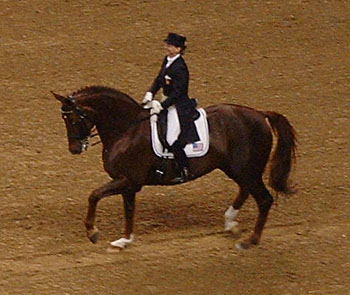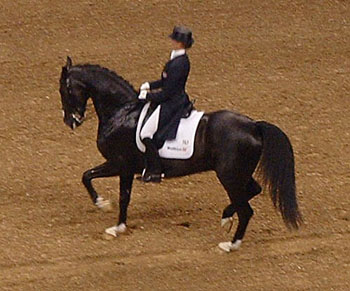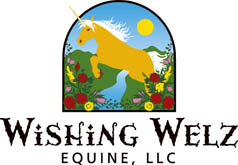What has Happened to Dressage?
A Personal Perspective
by Yvonne Welz ©2010
April 2010
As I write this article, I have been riding horses for 23 years, and seriously studying “Dressage” for 21 years. I have spent many years participating in and observing shows, clinics and events. I have read nearly every great book on the equestrian arts. I have studied with classical trainers, as well as competition trainers. I have ridden daily. I have reflected deeply upon all that I have observed, and what it means to me. This is simply my personal perspective on the overwhelming changes that have taken place in those 21 years.
When I first entered the world of classical riding, also known as Dressage, the shining stars at the top of the competitive arena were the likes of Reiner Klimke and Anne-Grethe Jensen. Their style, though showing some differences, was still not far from the classical ideals as epitomized by the Spanish Riding School of Vienna and other classical insitutions. Harmony and obedience, invisible aids, polls at the highest point, and pure gaits full of expression were what was considered excellent for BOTH competition and classical riders. Dressage was Dressage: maybe there were variations of style and emphasis, but good riding was still good riding, and easily recognized as such.

Debbie McDonald riding Brentina. They were a pair that always looked far more classical and correct, in my opinion. They exuded calmness and harmony. They were also often criticized for not being flashy enough! Flash is more important than harmony?
(Photo from my trip to the Las Vegas World Cup Dressage in 2005.)
Flash forward to recent years: a chasm has grown between traditional, classical riding and competition riding. This chasm has now grown so extreme, that Dressage is no longer Dressage! A disturbing trend is developing. Horses full of disobedience still medal at the Olympics. Calmness and harmony have been replaced by excessive limb movement and brilliance, often at the expense of the horse’s mental state. Due to these problems with the horse’s emotions, they must be ridden in ways that are in direct opposition to the directives of classical riding - overbending the necks to control their heads during training and warm-up is commonplace. “Dressage” has become a show spectacle, an audience extravaganza, with the excesses of humanity pushing these beautiful creatures to the very edge. Then we hear frequent stories of breakdowns, both mental and physical, which is, once again, in opposition to the values of traditional Dressage -- which has always been for the good of the horse!
How can we still call what we see in the sport, “Dressage”?! Even the rules are broken: the horses’ leg movements usually do NOT even match the rulebook. Gaits that are not pure are given scores of 10. Polls are rarely the highest point. Aids are sometimes very visible, horses display tension, and there is little relaxation and harmony. Correctness of execution of the pattern movements trumps the basic qualities of ease and harmony. Flash of the gaits trumps obedience and calmness. I don’t think we can still call this Dressage. The competition sport event where horses are ridden in a pattern inside a 60x20 meter rectangle should probably be renamed something else, unless we can return to the original purpose of displaying the training of the horse schooled in classical, traditional methods of riding in collection.
Either competition Dressage or classical Dressage needs to change its name, to be clear. Since classical Dressage came first, I vote that it should retain the title of Dressage. This new modern Dressage is a sporting event with values that are often very different than those of classical riding. Perhaps the sport riding should be called, “Competition Pattern Riding” or “Sport Ring Riding.” Let’s just quit pretending it is still the real genuine Dressage.
I don’t mean to sound harsh, or even be condemning those who practice sport ring riding. I actually have tremendous respect for anyone who competes at the highest levels, in any equestrian sporting event. The difference between classical and competition is well recognized by the top riders of elite competition Dressage, which are currently largely comprised of Dutch riders and their followers: they make the claim that they have developed a better system, a modern way of riding, for top sport. They differentiate between what they do, and what classical riders do. They talk about the “competition frame” of the horse, which is only used in the show ring, or for brief periods while training. This classical frame, with the poll the highest point (or that is the aim), is not the frame used by these show riders for schooling the horse. Instead, the horse is schooled in a “low deep and round” frame, sometimes with the muzzle even touching the chest. I know this is certainly NOT the system of all competition riders, but the top riders, using THIS SYSTEM, are sweeping the wins of every world competition Dressage title! They have taken over, and soon, if not already, this will probably be the normal way to ride “Dressage.”

Anky van Grunsven riding Salinero. She is probably the best known advocate of the new modern system of competition dressage training, for which she credits her overwhelming success. Here in the ring, she rides in the "competition frame," and her horse looks lovely in this moment. But does the end result justify the means? Does classical training play no role in the training of a top sport dressage horse? And can this horse levade? (Photo from my trip to the Las Vegas World Cup Dressage in 2005.)
I’m as much of a sucker for a beautiful horse as anyone else, and I admit to being enraptured by the breathtaking performances of some of the top winning horses with greatly exaggerated gaits, such as Blue Horse Matine, and Moorlands Totilas. But after taking a deep breath, standing back and asking the really hard questions, it becomes clear that the exaggeration of top dressage horses today is just not in the best interest of the horse’s soundness. Nor is it Dressage. Why are the FEI judges, through their world-record scores, telling us that this is the goal, the ideal, the correct Dressage horse?
The horses that win are shaping the evolution of the sport in ways that are in direct violation of the FEI directives and the classical masters. Yes, I know there ARE still competition riders and trainers out there doing things more correctly and classically, but this is a STRONG and pervasive trend. So strong and pervasive, and impossible to resist, that it is influencing everyone connected with competition, and filtering right down to the local and lower levels. Have you looked at Dressage magazines lately? Been to your local Dressage shows? Looked through photos of recent years' top winners? Be honest: Have you tried hard to see ANY examples of correct horses that are NOT overbent and broken at the 3rd vertebrae? They are few and far between. A big moving fancy horse with naturally good movement can be ridden overbent and win throughout the levels of competition dressage. The horse will never truly collect, but that simply is not needed these days, even in Grand Prix…
I have tried very hard to be objective, and to study different points of view throughout the years. When something bothers me, I study it even closer, and so I have looked into this new modern system of Dressage, buying books and DVDs of the top practitioners in an effort to unravel what was going on. Some of their basics are just fine, and no one would object to: they school their horses to be very sensitive and light, and they separate the aids by using hand without leg, and leg without hand. Some of this sounds very French! But in the end, everything goes amiss when the curb bit (or draw reins) with the active hand enters the picture, and horses are taught to go constantly overbent in the name of “stretching.” In this posture, horses cannot bend correctly at the poll, and the connection to the hind legs is lost. That is probably why there are no “half-halts” advocated in this system. This is why this system of riding is NOT Dressage, and not classical, traditional horsemanship. Horses for the modern system are carefully chosen to already be correct and flashy movers, well balanced by nature. This is not a system to improve the physique of the ordinary horse, but rather one to develop the flamboyance of a specially bred horse - a talented, hot, uphill mover - while creating the absolute submission needed to execute the upper level tests, and win.
How is this “Dressage”? Let’s take a look at how we can define Dressage. Classical rider Sylvia Loch dedicates the whole first chapter to the meaning of the word in her book, “Dressage, the Art of Classical Riding.” Dressage, coming from the French word “dresser” has been loosely translated to mean schooling or training of the horse. More accurately, it means to “put into alignment or prepare according to certain principles.” In modern use, it has come to mean any form of ring or school riding. Many people define Dressage as any training of the horse meant to develop its physique to better carry the rider’s weight. However, General Albrecht writes in “A Dressage Judge’s Handbook” that “Dressage should mean the advanced special education of some horses with particular aptitudes, after completion of the elementary education that all horses should receive.” Dressage becomes the word for “high-school dressage.”
Traditionally, Dressage has been about training the riding horse in collection. The ultimate expression becomes the airs above the ground. Upper level, Olympic level Dressage SHOULD be about collected horses, right?
In the late 90’s, researcher Dr. Hilary Clayton compiled data on top competition Dressage horses, and found that in most cases, there was no weight shift from the front to the hind legs during collection (The American Hanoverian Magazine, Fall 1999). A few horses did have a weight shift, but the study proved that competition success was not dependent upon weighting of the hindquarters. Classical rider Paul Belasik writes about this in his book, “A Search for Collection”: “This new kind of dressage was the antithesis of any previous descriptions and ideas about collection. Since collection had always been the heart and soul of dressage, I wondered if there was something inherent in competitive dressage that was allowing or even pushing an evolution away from classical principles to a different dressage, with different objectives, different concepts.” Paul went on to participate in studies with Dr. Clayton, which validated classical riding: his horses did indeed load their haunches.
If we define the highest levels of Dressage as riding a horse in finished collection, it becomes clear that modern sports riding has deviated from this model. The aim is no longer to have a collected horse, one that could easily go on to levade and other airs above the ground. Extension of the gaits has become so important that many horses win at Grand Prix without even showing a correct collected walk. Trot extensions are performed without true extension of stride: the forelegs are extended way out, yet the hind legs trail behind. Canter pirouettes are usually not seated or with a clear rhythm. Many piaffes are actually on the forehand. Photos and video often show horses that are not carrying their poll as the highest point, which means their neck is bent incorrectly. Haunches are often not lowered, and sometimes croups are even excessively high. This is not opinion, but observation, readily available to anyone. All of these items can be easily observed by freeze framing videos of any of the top winning Grand Prix horses. Again, this is not a condemnation of any person or horse – it is just an observation that things are not the same! And genuine collection does not have to exist – and usually does not - in today’s winning Grand Prix horse.
My favorite definition comes from Paul Belasik who describes the Classical Principles of Dressage as a “consensus” between all the great riders and trainers of the past several hundred years. (Dressage for the 21st Century) He is insistent that we do not need to re-invent anything. He writes, “The technical aspects of the fundamental principles of dressage have to be studied more, so that there is not a constant reinvention of the biomechanics of dressage. This work is finished. Despite recent developments in breeding, horses have not evolved recently in any manner that requires a re-examination of the principles of Gueriniere, Podhajsky, Steinbrecht, et al.”
When someone asks me what I do with my horses, I would love to be able to say “Dressage,” and know that any horse person will understand what I mean. I am following the consensus of the principles of the great horsemen throughout the past several hundred years, to prepare my horse for collection. Whether I compete or not is irrelevant: this is a journey of love and admiration for horses, with the intent of improving their lives, physically, mentally, and emotionally. Anything less is simply not Dressage.
The Classical Riding Club
A Worldwide Organisation - based in Scotland, Founded by Sylvia Loch in 1995 and still growing!
Join for a yearly fee of only about $28 USD and receive online access to a huge library of classical training information! Help support GOOD dressage riding! Network with like-minded horseowners and trainers. This positive group is making a big difference.
http://www.classicalriding.co.uk
